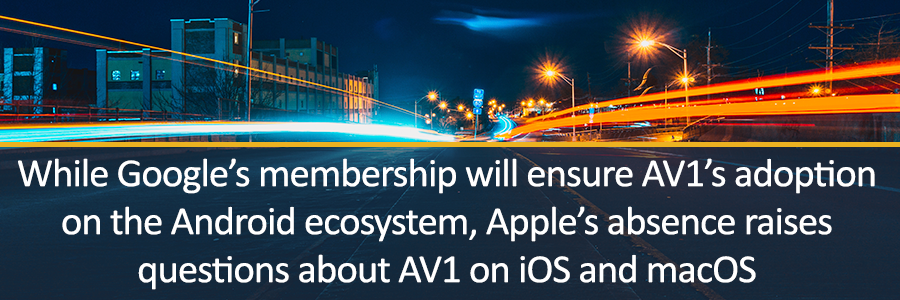Quality Video for the 21st Century – H.264 & H.265
Video codecs serve one key task: reducing the byte size of videos without drastically degrading their quality. Byte size is one of the most important characteristics when delivering video online, both from a costs perspective, with data heavy videos requiring more cloud storage and more CDN bandwidth to deliver, as well as from a viewer reach perspective, where viewers with mobile or slow internet connections cannot consume these videos at all.
Today, most video content on the web is encoded with the H.264 codec. Developed by the Motion Picture Experts Group (MPEG) and the Video Coding Experts Group (VCEG), H.264 has a history dating all the way back to 1999 and originally aimed to halve video byte size compared to any other video codecs in use.
While H.264 has been a solid video codec, a lot has changed since its creation, with the introduction of HDR, resolutions such as 4K and 8K, VR-, 3D- and 360°-video as well as the release of new computer techniques and hardware that could be used to encode video at substantially lower byte sizes.
To accommodate all these evolutions, other video codecs have since been developed. One of these video codecs is H.265, a direct successor to H.264, which delivers a considerably better byte size to quality ratio and which contains build-in optimizations to handle bigger resolutions such as 4K and 8K.

The need for a new and more powerful video codec is clear. So, why are not all videos today encoded with H.265? One big challenge that is hindering the widespread adoption of H.265 is royalty fees. H.265 is developed by a multitude of companies all of which own a series of patents on the underlying technology. Shipping a product with H.265, requires you to license these patents, with costs ranging in the millions of dollars, making the usage of H.265 a very expensive endeavor.
Licensing and Operational Costs – VP9
Where royalties are hindering the adoption of H.265, other companies have been working on providing working alternatives. One of these companies is Google, who provides a fully royalty free video codec named VP9. Aiming to replace H.264 as the primary video codec, VP9 also provides substantially better byte size to quality ratios. Furthermore, thanks to its royalty free model, it is today supported by about 3/4th of the web browsers and has hardware decode support available on all modern Android phones.
At YouTube, Google experienced first-hand what the storage and the content delivery costs are of running a major video website. Numbers from 2012 suggest YouTube was storing 80PB (petabyte) and delivering 500PB of video content per month. Saving just a couple percent on those numbers thanks to better video encoding could drastically reduce their bill.

For Google, VP9 was a solution to a direct problem: reduction in operational costs. VP9 is an excellent video codec that solves real problems, but it largely went unnoticed. While YouTube has a tremendous bandwidth and storage bill, most other video companies have been lacking somewhat behind, struggling to get their video content online at all. For them, H.264 was the stable and safer choice, proven in the industry. However, now that their infrastructure is in place, they too will start looking at reducing operational costs.
Next Generation Video – The Alliance for Open Media & AV1
Depending on whom you ask, on average VP9 is still outperformed by H.265. This, combined with the rapid rise of mobile video consumption, led to Google wanting even better compression for its mobile video products. With the rapid evolution in software and hardware technology, Google initially planned to release new versions of the VP codecs every 18 months, with VP10 planned to launch in 2016.
This plan ended abruptly on September 1, 2015, when Google announced the formation of The Alliance for Open Media (AOMedia) and the ceased further development of the VP codecs.
At the time of its formation three parties were all working individually on video codecs:
- Google, with the VP10 codec
- Cisco, with the Thor codec
- Mozilla & Xiph, with the Daala codec
While all three codecs were looking promising at the time, their split effort was hindering their development and ultimately their market adoption. Seeking to resolve these issues, the three parties decided to work together and formed the Alliance for Open Media.
With founding members including Amazon, Cisco, Google, Intel Corporation, Microsoft, Mozilla and Netflix, the alliance focuses on delivering a next-generation video format that is:
- Interoperable and open
- Optimized for the web
- Scalable to any modern device at any bandwidth
- Designed with a low computational footprint and optimized for hardware
- Capable of consistent, highest-quality, real-time video delivery
- Flexible for both commercial and non-commercial content, including user-generated content
Ultimately leading to the development of a new, open and royalty-free video codec named AOMedia Video 1 (AV1), with the ultimate goal of being 50% more bandwidth efficient compared to H.265.

Since its formation, the Alliance for Open Media has grown to include companies from all sectors:
But mainly the role of Google in AV1 is influencing, with them holding key positions in the browser, mobile devices and video services market, they are in prime position to push adoption of AV1 to the masses. Furthermore, with Microsoft and Mozilla as members, it is inevitable that most modern web browsers will get AV1 support. Google has promised that they will invest long term in the AV codecs and, similarly to the VP codecs, plans to release newer versions of the codecs every 18 months.
Potential Road Bumps – A Critical Look at AV1
While AV1 looks poised to revolutionize online video delivery, there are still some open questions that could have a significant impact on the adoption of the video codec.
First, AV1 promises drastic improvements in the byte size to quality ratios compared to H.265, however, the actual performance of AV1 to date is still unknown. The bitstream and specification of the codec are scheduled to be finalized near the end of 2017, and only after this date we can expect accurate results of third parties comparing its performance to H.264, VP9 or H.265 on their video infrastructure.
Furthermore, information on the hardware requirements for AV1 streaming at this point is still sketchy. Initial demonstrations during NAB 2017 required up to 200 virtual CPU cores to encode and stream one AV1 video channel. If these numbers are any indication of the actual hardware requirements for streaming AV1, this would surely hinder its adoption – with transcoding and streaming hardware being very expensive to upgrade and replace.
That also leaves the question on the hardware requirements for AV1 video playback, additionally relevant for video services targeting Smart TV consumption. Most Smart TVs today have H.265 codec support build-in on a hardware level. However, if those same Smart TVs are incapable of also supporting the AV1 codec, this could result in a very slow adoption of the codec, with the average turn-around time for TVs being multiple years.
A similar question remains about Apple devices. Google is in prime position to ensure AV1 gets adopted across the Android ecosystem, however Apple is currently completely uninvolved when it comes to AV1. Additionally, Apple recently announced that they will be supporting H.265 on their devices, leaving the question whether AV1 support is coming to Apple’s iOS and macOS devices unanswered.

Finally, while the marketing for AV1 is ramping up towards the bitstream finalization, there is also legal threat looming from the patent groups surrounding H.265. Similar threats were made in the past towards VP9 and even VP8, but the only time it went to court, no patent infringements were found and Google ended up victorious. The sure thing is, the patent groups surrounding H.265 are not going to sit by idle when AV1 is released to the public, however it remains to be seen what actions they will take to stop its adoption.
Conclusion – The Foreseeable Impact of AV1
We at THEOplayer are convinced that AV1 will have a definitive and positive impact on the online video industry. Not only do the members of the Alliance for Open Media have previous experience in the development of video codecs, but they also have first-hand experience with the problems they need to solve.
Whether AV1 will deliver the promised performance, we will have to see when the bitstream is finalized and experts start talking about their experience with the codec. As for the legal matters surrounding the codec, it is something to keep in mind, but it most likely will not create any significant obstacles . The real question is how quickly the codec gets adopted, both by device manufacturers but also by video services who need to upgrade or replace their existing streaming infrastructure.
In short, surely keep your eyes and ears open for news and performance rapports about AV1, but for now, depending on your viewer market and their devices, it might be wise to stick to H.264, go with VP9 or H.265 or even look at alternative's such as V-Nova's Perseus codec.
Get in touch with our team of experts to know more about how the market is going to evolve.




